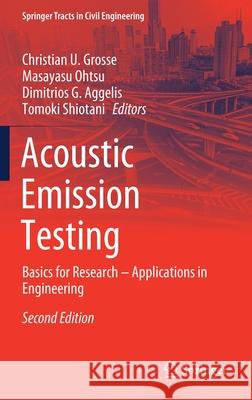Acoustic Emission Testing: Basics for Research - Applications in Engineering » książka



Acoustic Emission Testing: Basics for Research - Applications in Engineering
ISBN-13: 9783030679354 / Angielski / Twarda / 2021 / 752 str.
Acoustic Emission Testing: Basics for Research - Applications in Engineering
ISBN-13: 9783030679354 / Angielski / Twarda / 2021 / 752 str.
(netto: 881,78 VAT: 5%)
Najniższa cena z 30 dni: 886,75
ok. 22 dni roboczych.
Darmowa dostawa!
With contributions by numerous experts
Introduction.- History and Fundamentals.- Sensors and Instruments.- Parametric AE Analysis.- Signal-Based AE Analysis.- Source Localization.- Source Mechanisms.- Moment Tensor Analysis.- AE in Plate-like Structures.- General Remarks on Applications.- AE in Concrete.- AE applied to Superstructures.- AE applied to Substructures.- AE applied to Fresh Concrete.- AE in Masonry.- AE to Study Rock Stability.- AE in Laboratory Rock Mechanics.- AE in Metal.- AE in Wood.- AE in Biological Structures.- AE in Polymeric Composites.- AE in Ceramics and Ceramic Matrix Composites.- Wireless AE techniques.- Opportunities, Limitations, Accuracy and Skills.
Christian U. Grosse is professor of non-destructive testing at Technical University of Munich, Germany. His research interests focus on the application and development of non-destructive testing methods such as Acoustic Emission, Ultrasound, Impact-Echo, Vibration Analysis, Radar, IR Thermography as well as wired and wireless structural health monitoring.
Masayasu Ohtsu is emeritus professor at Kumamoto University, Japan, and is currently adjunct professor at the Laboratory on Innovative Techniques for Infrastructures, Kyoto University, Japan. Working as a world leader in the applications of acoustic emission and non-destructive testing to concrete, he organized two technical committees: TC212-ACD and TC239-MCM in RILEM.
Dimitrios Aggelis is professor at the Free University of Brussels, Belgium. His main area of interest includes characterization of cementitious materials, expanding also to composites and metals by use of non-destructive inspection techniques focused on elastic wave propagation. He was the recipient of the RILEM Robert L’Hermite medal of 2012.
Tomoki Shiotani is professor at Kyoto University, Japan. His research fields involve advanced NDT to assess such infrastructures as road bridges, dams, piers and so forth. He is currently Chairman of Research on AE for the Japanese Society of Non-Destructive Testing (JSNDI), and is a Past-Chairman of the Acoustic Emission Working Group (AEWG), USA. He is one of the founders of the International Institute of Innovative Acoustic Emission (IIIAE).
This book provides an introduction to Acoustic Emission Testing and its applications to different materials like concrete, steel, ceramics, geotechnical materials, polymers, biological structures and wood. Acoustic Emission Techniques (AET) techniques have been studied in engineering for a long time. The techniques are applied more and more to practical investigations and are more and more standardized in codes. This is because the degradation of structures due to ageing urgently demand for maintenance and rehabilitation of structures in service. It results in the need for the development of advanced and efficient inspection techniques. In mechanical engineering and concerning the monitoring of machines and mechanical components, AE is a widely accepted observing deterioration in the frame of structural health monitoring. The advantages of AE like sensitivity, damage localization potential, non-intrusive nature as well as developments in signal analysis and data transmission allow applications that could not be considered decades ago.
As such, AE techniques draw great attention to diagnostic applications and in material testing. This book covers all levels from the description of AE basics for AE beginners (level of a student) to sophisticated AE algorithms and applications to real large-scale structures as well as the observation of the cracking process in laboratory specimen to study fracture processes.
This book has proved its worth over the past twelve years. Now in its second edition, it will be a resource that sets the standard and equips readers for the future. All chapters from the 1st edition have been updated and rewritten and eight extra chapters (e.g also regarding AE tomography, AE in plate-like structures and AE for investigations of hardening of fresh concrete) have been added.
1997-2026 DolnySlask.com Agencja Internetowa
KrainaKsiazek.PL - Księgarnia Internetowa









